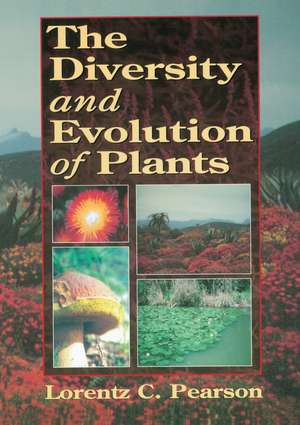The Diversity and Evolution of Plants
Autor Lorentz C. Pearsonen Limba Engleză Hardback – 18 dec 2020
Preț: 1003.39 lei
Preț vechi: 1338.55 lei
-25% Nou
Puncte Express: 1505
Preț estimativ în valută:
192.02€ • 199.73$ • 158.53£
192.02€ • 199.73$ • 158.53£
Carte tipărită la comandă
Livrare economică 15-29 aprilie
Preluare comenzi: 021 569.72.76
Specificații
ISBN-13: 9781138407848
ISBN-10: 1138407844
Pagini: 654
Dimensiuni: 187 x 235 mm
Greutate: 1.37 kg
Ediția:1
Editura: CRC Press
Colecția CRC Press
ISBN-10: 1138407844
Pagini: 654
Dimensiuni: 187 x 235 mm
Greutate: 1.37 kg
Ediția:1
Editura: CRC Press
Colecția CRC Press
Public țintă
UndergraduateCuprins
PART I. INTRODUCTION -- 1. Plant Diversity and Classification -- Concepts of Classification -- Categories of Classification -- Kingdoms of Living Organisms -- Subkingdoms, Divisions, and Classes of Plants -- Botanical Research -- Botanical Nomenclature -- Suggested Reading -- Student Exercises -- Special Interest Essay 1-1 -- Special Interest Essay 1-2 -- 2. Plant Diversity in Time and Space -- The Fossil Record -- Ecology and Plant Diversity -- Life Cycles -- Botany and Human Survival -- Suggested Reading -- Student Exercises -- Special Interest Essay 2-1 -- PART II. THE RED LINE -- 3. Prokaryotes or Fission Plants -- Class 1. Schizomycopsida -- Class 2. Cyanophycopsida -- Viruses -- Suggested Reading -- Student Exercises -- 4. Red Seaweeds -- Class 1. Rhodophycopsida -- Suggested Reading -- Student Exercises -- Special Interest Essay 4-1 -- 5. Terrestrial Fungi: Molds and Mushrooms -- Microkaryophytes -- Class 1. Ascomycopsida -- Fungi Imperfecti -- Class 2. Zygomycopsida -- Class 3. Basidiomycopsida -- Suggested Reading -- Student Exercises -- Special Interest Essay 5-1 -- Special Interest Essay 5-2 -- 6. Lichens and Other Symbiotic Plants -- Lichens -- Mycorrhizae -- Other Symbioses -- Suggested Reading -- Student Exercises -- PART III. THE BROWN LINE -- 7. Fire Plants and Cryptophytes -- Class 1. Cryptophycopsida -- Class 2. Dinophycopsida -- Suggested Reading -- Student Exercises -- Special Interest Essay 7-1 -- 8. Slime Molds -- Class 1. Acrasiomycopsida -- Class 2. Labyrinthulomycopsida -- Class 3. Myxomycopsida -- Suggested Reading -- Student Exercises -- 9. The Ubiquitous Algae: Diatoms and Other Chrysophytes -- Class I. Xanthophycopsida -- Class 2. Chyrsophycopsida -- Class 3. Bacillariophycopsida -- Suggested Reading -- Student Exercises -- Special Interest Essay 9-1 -- Special Interest Essay 9-2 -- 10. Flagellated Fungi -- Class 4. Mastigomycopsida -- Suggested Reading -- Student Exercises -- Special Interest Essay 10-1 -- 11. Kelps and Other Brown Seaweeds -- Class 1. Phaeophycopsida -- Suggested Reading -- Student Exercises -- Special Interest Essay 11-1 -- PART IV. THE GREEN LINE -- 12. Euglenids -- Class 1. Euglenophycopsida -- Suggested Reading -- Student Exercises -- 13. The Pond “Mosses'’, Siphonophytes, and Stoneworts -- Class I. Chlorophycopsida -- Class 2. Siphonophycopsida -- Class 3. Charophycopsida -- Suggested Reading -- Student Exercises -- Special Interest Essay 13-1 -- Special Interest Essay 13-2 -- 14. Mosses and Liverworts -- Class 1. Hepaticopsida -- Class 2. Bryopsida -- Suggested Reading -- Student Exercises -- 15. The Fern Allies and Origin of the Vascular Plants -- General Characteristics of the Tracheophyta -- Class I. Psilopsida -- Class 2. Lycopsida -- Class 3. Sphenopsida -- Suggested Reading -- Student Exercises -- Special Interest Essay 15-1 -- 16. Ferns -- Class 4. Filicopsida -- Suggested Reading -- Student Exercises -- 17. Plants with Seeds: the Gymnosperms -- Class 5. Pinopsida -- Class 6. Gnetopsida -- Suggested Reading -- Student Exercises -- Special Interest Essay 17-1 -- 18. Plants with Seeds: the Flowering Plants -- Class 7. Anthopsida -- Suggested Reading -- Student Exercises -- Glossary -- Bibliography -- Index.
Recenzii
"There can be no other word to describe this book than the term 'encyclopaedic.' Its 640 pages, 86 tables and 182 well-chosen illustrations provide a veritable mine of information and from an interdisciplinary point of view. It can, without any reservation, be recommended for its unexcelled presentation of material valuable for environmental conservation specialists..."
Richard Evans Schultes, Botanical Museum of Harvard University in Journal of Ethnobiology
"…a carefully structured and well-presented textbook that makes a special effort to provide students with starting poits for additional studies…because of its very readable style, this book will interest students to really think about plant evolution in a broad sense rather than simply learn facts."
-Northeastern Naturalist
Richard Evans Schultes, Botanical Museum of Harvard University in Journal of Ethnobiology
"…a carefully structured and well-presented textbook that makes a special effort to provide students with starting poits for additional studies…because of its very readable style, this book will interest students to really think about plant evolution in a broad sense rather than simply learn facts."
-Northeastern Naturalist
Descriere
Examines the concepts of evolution as the underlying cause of the rich diversity of life on Earth. This book introduces the variety of plant life during past ages, manifested by fossil records, using a natural classification system.
